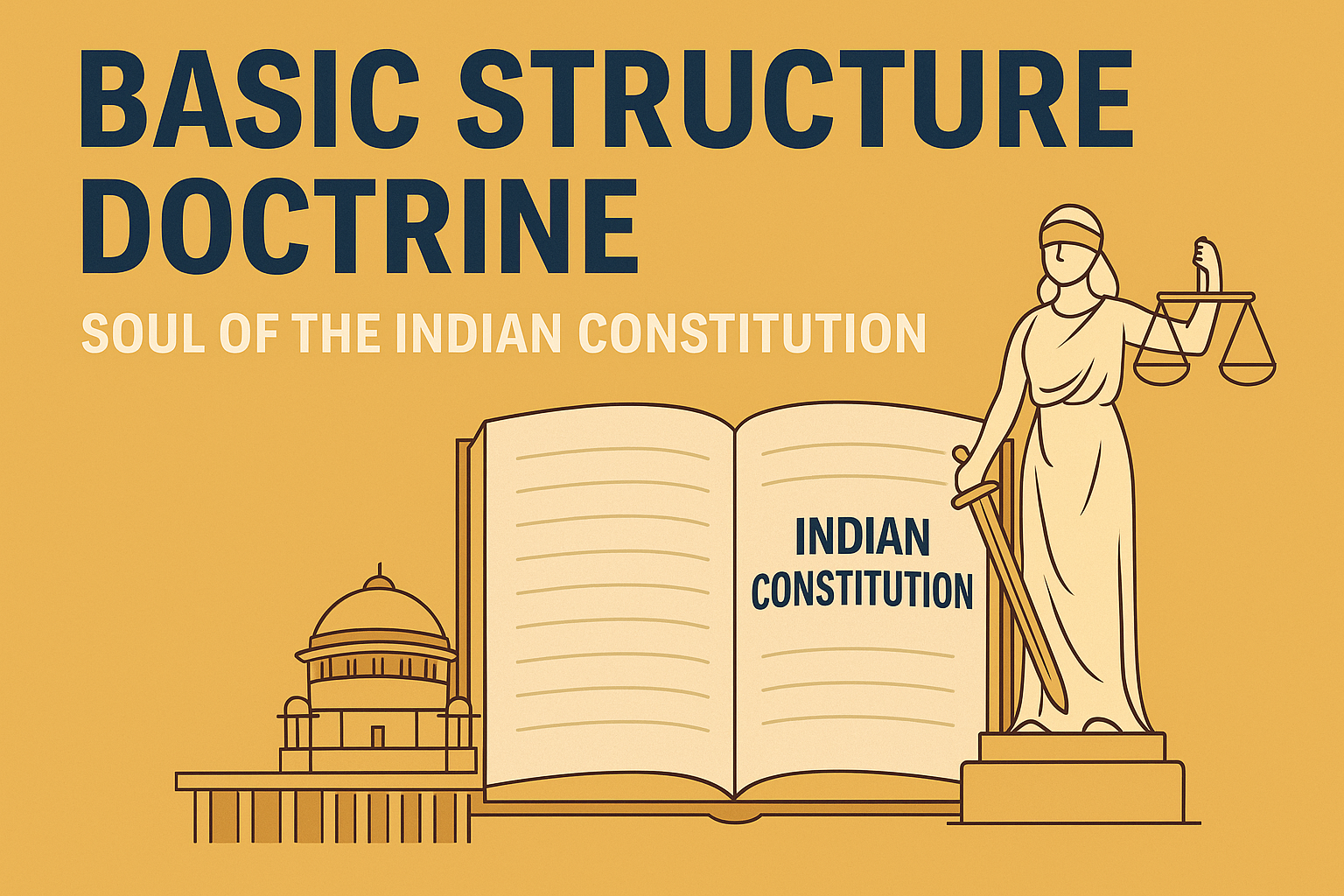🇮🇳 Part1 – Union and its Territory (Article 1–4)
🇮🇳 India at Independence (15 August 1947)
At independence, India was a mixture of:
- British Indian Provinces (directly ruled by the British)
- Princely States (ruled by local kings under British suzerainty)
🧩 Initial Classification of States (1950 Constitution)
When the Constitution came into effect on 26 January 1950, Indian territory was classified into 4 types of states:
🟥 Part A States (9)
- Former British provinces
- Had a Governor appointed by the President
- Had an elected legislature
- Examples: West Bengal, Madras, Bombay, Bihar
🟦 Part B States (9)
- Former princely states or unions of princely states
- Governed by a Rajpramukh (former prince), appointed by the President
- Had an elected legislature
- Examples: Hyderabad, Jammu & Kashmir, Madhya Bharat, Saurashtra
🟩 Part C States (10)
- Included both former Chief Commissioner’s provinces and some princely states
- Governed by a Chief Commissioner appointed by the President
- No legislature or limited powers
- Examples: Ajmer, Bhopal, Coorg, Delhi.
🟨 Part D (1)
- Andaman and Nicobar Islands
- Administered by a Lieutenant Governor appointed by the President
🔁 Reorganisation of States — Based on Language
❗Why?
- Many protests and demands for states based on linguistic identity
- People felt language was key to cultural and administrative unity
📚 Important Commissions/Events
🔹 1. Dhar Commission (1948)
- Recommended against formation of states on linguistic basis
- Said it would threaten national unity
- Public outrage followed this decision
🔹 2. JVP Committee (1949)
- Members: Jawaharlal Nehru, Vallabhbhai Patel, Pattabhi Sitaramayya
- Rejected linguistic basis but agreed it could be reconsidered later
- Favoured national integration over linguistic demands
🔥 3. Death of Potti Sriramulu (1952)
- Went on hunger strike demanding a separate state for Telugu-speaking people
- Died after 56 days of fast
- Led to massive protests
🌟 4. Formation of Andhra State (1st Oct, 1953)
- First state formed on linguistic basis
- Carved out from Madras Presidency
- This encouraged other linguistic groups to demand similar treatment
🏛️ States Reorganisation Commission (SRC), 1953
- Chairperson: Fazl Ali
- Members: K.M. Panikkar, H.N. Kunzru
- Recommended:
- Reorganising states on linguistic basis, but with national unity and administrative efficiency in mind
- Abolition of Part A, B, C, D
📜 States Reorganisation Act, 1956
- Effective from 1 November 1956
- Major overhaul of India’s internal map
- Created 14 states and 6 Union Territories
- Part A, B, C, D system abolished
🔁 Post-1956 Developments
India continued to evolve:
- Gujarat & Maharashtra (1960)
- Punjab Reorganisation (1966) → Creation of Haryana
- Sikkim becomes full-fledged state (1975)
- Chhattisgarh, Uttarakhand, Jharkhand (2000)
- Telangana (2014)
✅ Article 1 – Name and territory of the Union
- India, that is Bharat, shall be a Union of States.
- The States and the territories thereof shall be as specified in the First Schedule.
- The territory of India shall comprise—
(a) the territories of the States;
(b) the Union territories specified in the First Schedule; and
(c) such other territories as may be acquired.
📌 Key Points:
- India, that is Bharat, shall be a Union of States.
- The territory of India shall consist of:
- The territories of the states
- The Union Territories (UTs)
- Any territory that may be acquired by India in future
🧠 Conceptual Understanding:
- The word “Union” signifies that:
- India is not a federation formed by an agreement between states
- States cannot secede from the Union
- The Union is indestructible, even if states are reorganized or merged
📌 Important Schedules:
- First Schedule of the Constitution contains:
- List of States and their territories
- List of Union Territories
📘 Federal Structure: India vs USA
🇺🇸 USA – A True Federation
- Formed when small sovereign states agreed to join together.
- They formed a federation through an agreement.
- Each state had sovereignty before the union.
- Hence, USA is a “True Federation”.
🧠 Key:
States decided → Agreement → Federation → True Federal Model
🇮🇳 India – A Union of States
- India has a federal structure, but not a true federation.
- The Indian Union was not formed by agreement of sovereign states.
- Indian states were carved out by the Constitution.
- The states are not sovereign.
- Hence, India is called a “Union of States”, not a federation.
🧠 Key:
Large country → Carved into small states → No agreement → Not sovereign → “Union of States”
🌍 Classification of Nations
🟩 1. Unitary Nation
- All powers are concentrated in one central government.
- States/provinces do not have independent powers.
- Example: United Kingdom
🧠 Key Feature: Power flows top-down. The central government can create or abolish local governments.
🟦 2. Federal Nation
- Power is divided between the centre and the states by the Constitution.
- Both levels of government are independent within their spheres.
- Examples:
- USA — A true federation (formed by agreement of sovereign states)
- India — A federal system with unitary bias (quasi-federal)
🧠 Key Feature: Constitutionally defined division of powers; both Centre and States derive power directly from the Constitution.
🇮🇳 Where does India stand?
- India has features of both:
- Federal structure (dual polity, written Constitution, division of powers)
- Unitary features (strong Centre, single Constitution, emergency provisions)
Hence, India is called a “Quasi-Federal” or “Federal with Unitary Features” nation.
🏛️ Federal Features of the Indian Constitution
1️⃣ Independent Judiciary
- The Constitution provides for an independent judiciary headed by the Supreme Court of India.
- It is ensured through:
- Security of tenure of judges
- Fixed service conditions
- Judiciary acts as the guardian of the Constitution and resolves Centre-State disputes.
2️⃣ Division of Powers
- The Constitution divides legislative powers between Centre and States through:
- Union List
- State List
- Concurrent List
(Mentioned in Seventh Schedule)
- Subjects not mentioned in any list fall under the Residuary Powers, which belong to the Centre.
3️⃣ Bicameralism
- The Parliament is bicameral, i.e., it has two Houses:
- Lok Sabha (House of People)
- Rajya Sabha (Council of States)
- Rajya Sabha represents the states, with members elected based on their population.
🧠 Why This Is Important for UPSC:
These features justify that India has a federal structure, even though it also carries unitary features (which you’ll study next). In mains, this helps justify why India is described as a “Quasi-Federal” state — federal in form, unitary in spirit.
🧠 Expert Opinions on Indian Federalism
🔹 1. Granville Austin — Cooperative Federalism
“The Constitution of India was perhaps the first constituent body to embrace from the start what A.H. Birch and others have called cooperative federalism.”
📝 Meaning:
- Though India is not a true federation, the Centre and States are expected to cooperate rather than compete.
- The Indian system promotes joint responsibility, especially in areas like education, environment, and planning.
- Example: GST Council, NITI Aayog, and disaster management — all reflect cooperative federalism.
🔹 2. Chief Justice Beg — “Amphibian Constitution”
“The Constitution is ‘amphibian’, in the sense that it can move either on the federal or on the unitary plane, according to the needs of the situation and circumstances of a case.”
📝 Meaning:
- Like an amphibian lives in both water and land, India’s Constitution works in both federal and unitary modes.
- In normal times, it behaves federally (dual government, division of powers).
- In emergencies or special cases, it becomes unitary (Centre dominates, states’ powers shrink).
- This is why India is often called quasi-federal or federal with unitary tilt.
📝 How to Use in Mains (GS-2 / Polity):
- Quote Granville Austin to show that Indian federalism is built on cooperation, not just division.
- Quote Justice Beg to explain flexibility and centralized strength during crises.
✅ Article 2 – Admission or establishment of new States
📌 Key Points:
- Parliament may by law:
- Admit new states into the Union
- Establish new states
🧠 Difference Between ‘Admission’ and ‘Establishment’:
| Term | Meaning |
|---|---|
| Admission | Adding an already existing foreign territory into the Union (e.g., Sikkim, Pondicherry) |
| Establishment | Creating a new state from scratch or out of existing territory (rare, mostly theoretical) |
📌 Power Holder:
- Only Parliament has the power to admit/establish new states.
✅ Article 3 – Formation of new States and alteration of areas, boundaries or names of existing States
📌 Powers Granted to Parliament:
Parliament may by law:
- Form a new state:
- By separation of territory
- By uniting two or more states or parts of states
- Increase the area of any state
- Diminish the area of any state
- Alter the boundaries of any state
- Alter the name of any state
🧭 Procedure to be followed:
- Bill must be introduced with prior recommendation of the President
- President refers the bill to the concerned State Legislature for its views
- They must respond within a fixed time
- However, their opinion is not binding
- Parliament can then pass the bill by a simple majority
🧠 Key Points:
- States cannot veto changes in their territory
- Even without the consent of the state, Parliament can act
- Most state bifurcations/mergers/name changes happen under Article 3
- E.g., Andhra Pradesh, Telangana (2014), Bombay → Maharashtra & Gujarat (1960)
✅ Article 4 – Supplementary provisions related to Articles 2 and 3
📌 Key Points:
- Laws made under Article 2 and 3 can make changes to First and Fourth Schedules of the Constitution
- First Schedule: List of States and UTs
- Fourth Schedule: Allocation of seats in Rajya Sabha
- Such laws are NOT considered Constitutional Amendments
- Hence, do not require Article 368 process
🧠 Significance:
- Simplifies the process of reorganization
- Empowers Parliament to act quickly and flexibly
- No need for 2/3rd majority or state ratification
🧾 Quick Summary Table
| Article | Provision | Power Holder | Special Features |
|---|---|---|---|
| Art. 1 | Name and territory of the Union | — | Defines India as a Union of States |
| Art. 2 | Admission/establishment of new states | Parliament | Deals with external territories |
| Art. 3 | Reorganization of states | Parliament (with President’s recommendation) | Deals with existing states |
| Art. 4 | Laws under Art 2 & 3 not constitutional amendments | Parliament | Simplifies reorganization |
🧠 Key Prelims Facts:
Telangana was created under Art. 3 in 2014
Only simple majority needed for Articles 2–3 laws
State legislature’s opinion under Art. 3 is not binding
Sikkim was added using Art. 2 in 1975


